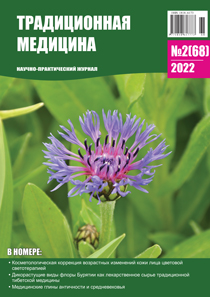Wild medicinal plants of the flora in Buryatia used as medical raw material in traditional tibetan medicine
DOI:
https://doi.org/10.54296/18186173_2022_2_21Keywords:
wild medicinal plants of the Buryat flora, traditional tibetan medicineAbstract
Tibetan medicine is widespread in the Buddhist region of the Russian Federation - the Republic of Buryatia but is not formally recognized in Russia. Up to 466 plant species have been used as medicinal raw material in Tibetan medicine in Buryatia, and the greater part of the raw material are substitutes, with most of them being replaced based on their botanical affiliation. This article deals with the statistical analysis of the number of scientific articles addressing the research on the chemical composition and pharmacological properties of 90 non-pharmacopoeial plants growing in Buryatia and used in Tibetan medicine, as well as of the raw material supply state of these species, with the view that the article may serve as a resource guide for assessing the possibility of their further research and medical application. It is determined that 46 non-pharmacopoeial species of the Buryat flora used in Tibetan medicine are included in the Pharmacopoeias of the bordering countries and are actively studied in China and Mongolia. There are few or no scientific entries on the chemical composition and pharmacological properties of 33 non-pharmacopoeial species in the ScienceDirect.com database. There are low-scale resource stocks for 61 species out of the 90 selected species. The use of 21 non-pharmacopoeial wild plant species of Buryatia for dietary supplements is banned in Russia, and these species may be introduced into medical application as pharmacopoeial plants only, meaning that extensive pre-clinical and clinical trials and researches of the chemical composition of the active ingredients will be needed. The Buryat researchers have studied the chemical composition and pharmacological properties of 13 species out of the 90 selected plants growing in Buryatia.
References
The transnational Sowa Rigpa industry in Asia: new perspectives on an emerging economy / S. Kloos, H. Madhavan, T. Tidwell [et al.] // Social Science & Medicine. – 2020. –Vol. 245. – 112617.
Tibetan medical informatics: An emerging field in Sowa Rigpa pharmacological and clinical research / W. Dhondrup, T. Tidweli, X. Wang, [et al.] // J. Ethnopharmacology. – 2020. – Vol. 250. – 112481.
Чжуд-ши. Канон тибетской медицины / пер. с тиб., предисл., примеч., указ. Д.Б. Дашиева. – М.: Вост. лит., 2001. – 766 с.
Гаммерман, А.Ф. Словарь тибетско-латино-русских названий лекарственного растительного сырья, применяемого в тибетской медицине / А.Ф. Гаммерман, Б.В. Семичов. – Улан-Удэ, 1963. – 61 с.с.
Номенклатура лекарственного сырья, применяемого в тибетской медицине /Л.П. Сыбденова, С.Э. Баяндуров, Е.И. Саканян, М.С. Томкевич. – М.: РАНМ, 2012. – 100 с.
Ленхобоев, Г.Л. О теплых и холодных свойствах пищевых продуктов и лекарственных средств / Г.Л. Ленхобоев, Н.Ц. Жамбалдагбаев Н.Ц.. – Новосибирск, 1980. – 55 с.
Определитель растений Бурятии. – Улан-Удэ, 2001. – 672 с.
Государственная фармакопея РФ ХIV издания. Федеральная электронная медицинская библиотека Минздрава РФ. – М., 2018. – [Электронный ресурс]. – URL: http://femb.ru/feml
Конспект флоры Азиатской России: Сосудистые растения / под ред. К.С. Байкова. – Новосибирск: Изд-во СО РАН, 2012. – 640 с.
Dataset of Materia medica in Sowa Rigpa: Tibetan medicine botanicals and Gawe Dorijes classification system / R. Wangyal, T. Ti dwell, W. Dhondrup [et al.] // Data in Brief. – 2020. – Vol. 33. – 106498
2020 The status quo and way forwards on the development of Tibetan medicine and the pharmacological research of Tibetan Metaria Medica / K. Fu, M. Xu, Y. Zhou [et al.] // Pharmacological Reseach. – 2020. – Vol. 155. – 104688.
Тибетская медицина у бурят / Т.А. Асеева, Д.Б. Дашиев, А.Д. Дашиев [и др.]; отв. ред. О.Д. Цыренжапова. – Новосибирск: Изд-во СО РАН, 2008. – 324 с.
Сумати Праджня. Кунпан дудзи (Полезный для всех экстракт амриты): Большой рецептурный справочник Агинского дацана / Сумати Праджня; пер. с тиб., предисл., примеч., указ. Д.Б. Дашиева. – М.: Вост. лит., 2008. – 214 с.
Ресурсы лекарственных растений Забайкалья / В.М. Шишмарев, Г.Л. Шиш Ленхобоев, Н.Ц. Жамбалдагбаев, Т.М. Марева. – Улан-Удэ: изд-во БНЦ СО РАН, 2017. – 200 с.
Красная книга редких и находящихся под угрозой исчезновения видов животныхи растений Бурятской АССР / под ред. А.И. Плотникова. – Улн-Удэ: Бурят. кн.. изд-во, 1988. – 416 с.
Красная книга Республики Бурятия: редкие и исчезающие виды растений и грибов.- 2-е изд. – Новосибирск: Наука, 2002. – 340 с.
Красная книга Республики Бурятия: Редкие и находящиеся под угрозой исчезновения виды животных, растений и грибов. – Улан-Удэ: изд-во БНЦ СО РАН, 2013. – 688 с.
Pharmacopoeia of the PPRC Plant List (2015) [Электронный ресур] // Southern Cross University/ Analytical research University URL: https://www.scu.edu.au/analytical-research-laboratory---arl/herbal-authentication/pharmacopoeial-monographs/pharmacopoeia-of-the-pprc-plant-list/
Монгольская Национальная Фармакопея. Министерство здравоохранения. 1-е изд. – Улаанбаатар. – 2011. – 934 с.
Перечень компонентов растительного и животного происхождения, запрещенных для использования в составе БАД. Дополнения и изменения № 7. Утверждены постановлением Главного гос. сан. врача РФ от 05.03.2008 г. № 17 СанПин 2.3.2.1078-01. Гигиенические требования к безопасности и пищевой ценности пищевых продуктов. – М., 2001.
Открытые реестры изобретений РФ [Электронный ресурс] URL: www.new.fips.ru/registers.
Лекарственные средства на основе растительных ресурсов Байкальского региона / Е.В. Петров, Г.В. Чехирова, Т.А. Асеева, С.М. Николаев. – Новосибирск: Изд-во СО РАН, 2008. – 94 с.
Downloads
Published
How to Cite
Issue
Section
License
Reproduction of any materials without the written permission of the publisher is prohibited.
The responsibility for the accuracy of the information contained in articles and advertisements are the authors and advertisers.






